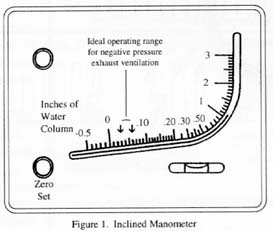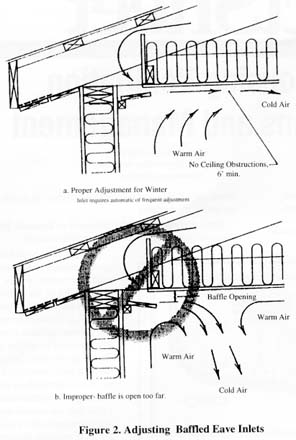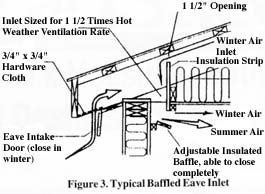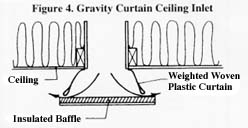
Glen J. Arnold
Michael A. Veenhuizen
Properly sized and managed air inlets are critical to the successful operation of a mechanically ventilated livestock building. When air inlets are not properly located, designed and managed by the livestock producer, animals can become stressed resulting in sickness and reduced performance.
In a negative pressure mechanically ventilated livestock building the fan's size and speed determine the amount of fresh air entering the building. However, it is the location, design, and management of the air inlet that ensures uniform air distribution and reduces drafts and dead air pockets.
During cold weather, the air inlet must direct incoming cool air into the building at a high enough velocity to blend it with warm room air before it reaches the animal space. During hot weather the air inlet must be sized to permit a large volume of air to enter the animal zone to promote air movement past the animals and prevent heat stress.
In a mechanical ventilation system, the fan creates a pressure difference between the inside of the building and the outside. This pressure difference is called static pressure and is the force that moves fresh air into buildings through air inlets or forces air out of the building through air outlets. Neutral pressure systems use fans to force air into and other fans to force air out of a building. This creates an equal or neutral pressure between the inside and outside of the building.
Static pressure is usually measured in livestock buildings with a device called an inclined manometer.

A properly sized and managed ventilation system should usually operate within the range of .04 to .06 inches of static pressure. Most livestock ventilation fans used for negative pressure exhaust ventilation are sized to operate efficiently in this static pressure range. A static pressure of .04 to .06 usually results in an air velocity of approximately 1,000 feet per minute across the inlet which allows incoming air to mix and temper before entering the animal area.
Static pressure affects the air velocity across the inlet and the airflow capacity of a fan. Higher static pressures increase air velocity across an inlet and decreases fan airflow capacity. A decrease in fan airflow capacity results in a lower air exchange rate.
The desired air inlet velocity into a room is between 800-1,000 fpm. Figure 2 shows proper and improper adjustment of baffled inlets for cold weather. Incoming air traveling at greater than 1,200 feet per minute may not adequately mix with warm room air and enter into the animal zone. High velocity air may stay near the ceiling and exit the exhaust fan while only mixing the upper portion of the air.

A low static pressure increases fan air delivery capacity and the air exchange rate, but the incoming cooler air falls more quickly and can cause stress on animals near the inlet resulting in illness and reduced animal performance.
A wide variety of air inlets are available for use in mechanical ventilation systems. They must be located, installed and operated properly to provide optimal air distribution.
Figure 3 shows a typical baffled eave inlet. During cold weather, the eave intake door is closed so that tempered air can be pulled from the attic. During warm and hot weather, the eave intake door is open so most of the air enters this opening. The adjustable insulated baffle is usually controlled by a hand wench and should be adjusted to maintain a static air pressure between .04 and .06 inches water column as measured by a manometer.

Figure 4 is an example of a baffle inlet usually located in the ceiling which allows tempered air from the attic to enter the animal area. This inlet design is normally utilized for winter ventilation in livestock buildings to bring tempered air from the attic to the livestock area at minimum winter ventilation rates. Tempered air can be pulled from the attic and directed across the ceiling to provide fresh, uncontaminated air and prevent dead pockets of stale air. These inlets should be closed during mild and hot weather when the temperature of the attic air gets too hot. A ceiling inlet can be used during hot weather if an insulated air supply duct is used to reduce temperature increase in incoming inlet air. If only used for minimum winter ventilation, these inlets can be set at the proper opening so that little or no adjustment is required throughout the winter months.

A gravity curtain inlet can be used as a ceiling inlet or wall inlet to provide incoming fresh air. A gravity curtain inlet is self adjusting and opens with changes in static pressure and fan airflow. The curtain usually has a metal rod running the length of the curtain to hold it nearly closed during minimum winter ventilation. This weight helps to maintain the proper static pressure and thus the proper air inlet speed. Caution should be taken with "home-made" gravity curtain inlets such that the weight is not too heavy and does not allow the curtain to open during low ventilation rates.
The weighted curtain must be protected from cold winter winds because winds can force the curtain open and allowing too much cold air to enter the animal area. Drafts created by improperly adjusted inlets can stress young animals. Self-adjusting wall inlets are commonly used because they are simple, self adjusting, and easy to clean. These type of inlets are typically designed to maintain a static pressure across the inlet of .04 to .06 inches of water column. An adjustable weight or spring is used to change the static pressure setting for different seasons. They are usually used to provide air a tempered hallway or airspace. These inlets should be protected from wind pressure affects that can push too much cold air in through the inlet.
Livestock rooms wider than 25 feet are difficult to properly ventilate with inlets located on one wall and fans located on the opposite wall. Buildings wider than 25 feet should have inlets along both outside walls and buildings wider than about 40 feet need interior ceiling inlets for adequate air distribution. When locating self-adjusting inlets be aware that uniform air distribution is critical during cold weather.
Power-operated inlets can be used in conjunction with the fan controller. These inlets typically come open when the exhaust fan comes on or may be set on a timer to open periodically and allow fresh air to enter the building. Power-operated inlets are usually more expensive and require electricity to open and close. Power-operated inlets can freeze shut during cold weather restricting fresh air intake. To prevent freezing problems remove one or two of the shutter blades to provide a permanent air take.
Several items should be considered when installing an air inlet to bring in fresh air in a mechanical ventilation system.
Air inlets that are located, designed and managed properly can assure the producer a good livestock environment. As you plan a new or remodeled livestock building using mechanical ventilation, take time to select and locate the air inlets properly. Once installed, periodically adjust and clean inlets.